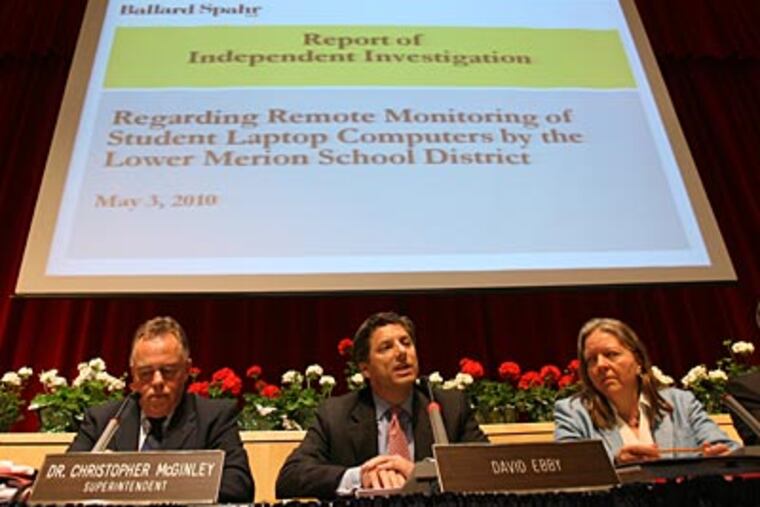Lower Merion report rips “overzealous” Web cam use
Inconsistent policies. Shoddy recordkeeping. Misstep after misstep. "Overzealous" use of technology, "without any apparent regard for privacy considerations."

Inconsistent policies. Shoddy recordkeeping. Misstep after misstep. "Overzealous" use of technology, "without any apparent regard for privacy considerations."
Those were the conclusions a team of lawyers and computer experts reached after a 10-week investigation into how, when and why Lower Merion School District turned on the Web cameras and software that secretly snapped thousands of photos and screenshots from student's laptops.
Its report, released Monday night, found that the software activated by the district in the past two years captured nearly 58,000 images, mostly from lost or stolen laptops.
But because no one turned off the tracking system, more than 50,000 of those images were taken after the computers had been recovered and given back to students.
Many were photos of students, their friends or families, in their homes or elsewhere, the report said.
None of the images appeared to show students in a compromising situtation, the report stated, and investigators said they found no proof that school staffers used the technology to spy on students.
Even so, the report portrayed employees in one of the region's elite public school districts as enamored by their cutting-edge technology but repeatedly blinded to its impact.
The improperly collected images, the report said, "resulted from the District's failure to implement policies, procedures and recordkeeping requirements and the overzealous and questionable use of technology by (information services) personnel without any apparent regard for privacy considerations or sufficient consultation with administrators."
The 69-page report, presented during a school board meeting at Harriton High School, was designed to be the most comprehensive explanation to date of the now-disabled tracking program that the Main Line school district installed on laptops it gave to nearly 2,300 high school students in the past two school years.
Released by Henry E. Hockeimer Jr., a former federal prosecutor hired by the district, the report marked the latest chapter in a saga that erupted with a lawsuit two months ago and has since sparked an FBI probe and international attention.
Some of the most pointed criticism seemed aimed at the technology staffers who set up and managed the system. According to the report, those employees "were not forthcoming" about the technology and were unwilling "to let anyone outside" of their department know about the tracking capabilities.
In particular, the report cited the district's longtime top technology administrator, Virginia DiMedio, for failing to let top district officials know of Web cam capabilities and to address the privacy implications.
DiMedio, who retired last year, was the only district employee who did not talk with the investigators. She has said that she refused to do so because the district would not pay for her lawyer.
According to the report, DiMedio's successor, George Frazier, told investigators that when he arrived last summer, he considered the department the Wild West - "because there were few officials policies and no manuals of procedures and personnel were not regularly evaluated."
Frazier had reservations about the use of the theft-tracking software, according to the report, but never got a chance to raise it with district lawyers because he was "focused on issues that he considered more pressing."
But others also deserved blame, the investigators said. School board members failed to ask the right questions. District lawyers didn't probe the legal aspects of handing out computers. Building administrators didn't talk about the ramifications.
The report was prepared by lawyers from Ballard Spahr, the same firm the district has hired to defend it in a lawsuit filed by Harriton High School sophomore Blake Robbins and his parents. Robbins, who was photographed in his Penn Valley home by his school-issued laptop, contends the system represented an invasion of his privacy.
According to the report, school officials dispute Robbins' account that he was partly undressed in one Webcam photo, as well as his mother's contention that she tried to contact school officials to discuss the tracking before filing the suit.
The lawyers and L3, a computer forensics firm, together reviewed more than 500,000 documents, images and emails to piece together the history and scope of the security system.
Their report offered many new details, but didn't promise to be the final word on the topic.
Investigators noted conflicting accounts from district employees and gaps in data - and said they were still gathering evidence as recently as Sunday. Their report laid out recommendations for new district policies, but also said they struggled to answer a central question in the controversy:
Why didn't anyone foresee the furor that has erupted?
"Our investigation leaves unresolved questions that raise serious questions about why so many images were captured without apparent regard for privacy considerations," the report said.